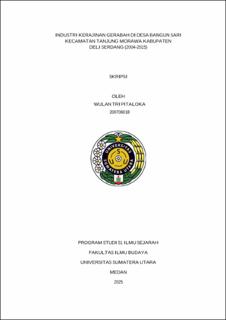| dc.description.abstract | This study examines the development of the pottery craft industry in Bangun
Sari Village during the period 2004–2015, a sector categorized within the creative
economy that plays a significant role in improving the welfare of the local
community. The objectives of this research are to explain the historical
establishment of the pottery craft industry in Bangun Sari Village in 2004, to
analyze the industry's contribution to local economic growth and community
welfare from 2004 to 2015, and to describe the overall development of the pottery
craft industry during that period. The research employs a qualitative approach
using a descriptive historical method, based on observations, interviews, and
literature review. The findings reveal that the pottery industry in Bangun Sari
Village experienced notable growth, marked by an increase in the number of
artisans, diversification of products, and the adoption of marketing strategies that
began to incorporate digital technologies. Despite this progress, the industry faces
several challenges, including limited access to capital, competition from mass
produced goods, and insufficient support in marketing and distribution. Therefore,
synergy among artisans, the government, and consumers is essential to ensure the
sustainability of the industry. The government can play a supportive role by
providing training programs, financial assistance, and facilitating broader market
access. On the other hand, artisans need to enhance product innovation and
develop more effective marketing strategies. Consumers also have a role in
supporting the industry by increasing their appreciation for local products.
Through collective efforts, the pottery craft industry in Bangun Sari Village can
continue to grow and make a greater contribution to the regional economy. | en_US |


